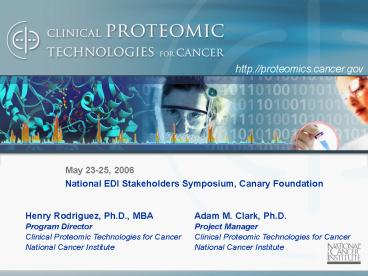CPTI - PowerPoint PPT Presentation
1 / 18
Title: CPTI
1
http//proteomics.cancer.gov
May 23-25, 2006 National EDI Stakeholders
Symposium, Canary Foundation
Adam M. Clark, Ph.D. Project Manager Clinical
Proteomic Technologies for Cancer National Cancer
Institute
Henry Rodriguez, Ph.D., MBA Program
Director Clinical Proteomic Technologies for
Cancer National Cancer Institute
2
Synergy of Discovery Technology
- New Biology--New Technology
- HT Sequencing
- Gene Expression Microarrays
- Comparative Genomics
- PROTEOMICS
- Cellomics
- Bioinformatics
- Systems Biology
Lee Hood, Institute for Systems Biology
3
Potential of Clinical Proteomics
- Clinical proteomic technologies offer the
potential opportunity to enable - Early detection of cancer
- Molecular imaging probe and sensor development
- Discovery of targeted drugs
- Rationally developed clinical trials (e.g.,
stratification, intermediate endpoints)
4
The Human Plasma Proteomegt10 Orders of Magnitude
in Abundance
Reference intervals for 70 protein analytes in
plasma
Anderson, N. L., and Anderson, N. G. (2002) The
Human Plasma Proteome History, Character, and
Diagnostic Prospects. Molecular Cellular
Proteomics, 1, 845-867.
5
Clinical Proteomic Technologies Initiative
Strategy
12 Proteins comprise up to 96 of the protein
mass in plasma
6
Proteomics and FDA Approved Diagnostic Tests
Anderson, N. L., and Anderson, N. G. (2002) The
Human Plasma Proteome History, Character, and
Diagnostic Prospects. Molecular Cellular
Proteomics, 1, 845-867.
7
Mass Spec Platforms - Configurations
8
Affinity-based Platforms Many Capture Agents
Affinity-based / Capture agents / Multiplex /
High Throughput
Challenges for capture agents are stability,
specificity, sensitivity, and selectivity. They
must be able to capture a single type of protein,
even if it is expressed at low levels, from a
sample containing tens of thousands of different
proteins.
9
Clinical Proteomics Today
- No single technology platform can satisfy all of
the desired proteomic measurements - No mature, true proteomic technology
- No performance criteria
- Poor confidence in protein measurement results
- Difficulty in assessing agreement of different
experiments - Conflicting reports in the literature
- Lost opportunities
Scott D. Patterson Ruedi H. Aebersold,
Proteomics the first decade and beyond, Nature
Genetics 33, 311-323 (2003)
10
Community Input and Consensus
- On the basis of discussions with a wide range of
clinicians, cancer researchers, and
technologists, the NCI recognized that there are
immense opportunities for using proteomics
technologies to solve mission-critical problems
in cancer research. - Premises
- Biomarkers exist in readily-accessible body
fluids - Panels of such markers will be required to
achieve high specificity and sensitivity - Current technology is capable of discovering
these panels - Current application of this technology can be
improved
11
Sources of Variability of Existing Proteomic
Technologies
- Specimen handling and processing
- Platform evaluation
- Technical (resolution, accuracy, dynamic range,
sensitivity, reproducibility) - Cross verification among platforms
- Data acquisition/Bioinformatics
- Data analysis
- Publication uniformity
- Goal Assurance that protein measurement results
are due to changes in the sample and not changes
or variability due to - Instrument
- Assay performance
- Reagents
- Operator
- Site
12
Challenges Exist to the Clinical Measurements of
Proteins
- Pervasive problems with research design, data
analysis, reproducibility, and comparability of
research results - Lack of common reagents and highly qualified
public data sets - Ineffective transfer of discovery technologies to
clinical application (technology gap) - Inability to manage and interpret large
quantities of pre-processed data - Private sector unable and unlikely to address the
challenges
13
Overcoming Challenges in Proteomics NCI Clinical
Proteomic Technologies Initiative for Cancer
- Scope 5-year, 104M
- Objective Integrated approach to assess, enhance
and develop proteomic technology measurement
capabilities
- Key Components
- Build a multidisciplinary team framework
- Refine and standardize technologies, and
statistical/analytical methods - Develop and evaluate new technical approaches
- Scientific Goals
- Build a foundation of technologies data
reagents and standards analysis systems and
infrastructure. - Systematically advance understanding of protein
biology in cancer - Accelerate discovery research and clinical
proteomics
14
Components of CPTI Program
- Clinical Proteomic Technology Assessment for
Cancer (CPTACs) - Evaluate existing proteomic analysis platforms to
reliably identify, quantify, and compare
peptides/proteins in complex biological mixtures - Mass spectrometry and Affinity-based technologies
- Advanced Proteomic Platforms and Computational
Sciences - Support highly innovative research in the
quantitative analysis of peptides/proteins of
interest in clinical cancer studies - Critical Proteomic Reagents Resource
- Proteins, peptides, antibodies, proficiency
testing materials, and informatics
15
Clinical Proteomic Technologies Initiative
Strategy
CPTAC Technology Assessment Cores
Affinity and Mass Spectrometry Platforms
Metrics, Antibodies, Proteins
Standards, Algorithms, Ontologies, Protocols
NCI Program Coordination Committee
Reagents and Resources Core
Advanced Proteomic and Computational Sciences
caBIG Common Bioinformatics Platform
Community Resources
- Proteomic Standards
- New Technologies
- Integrated Searchable Proteomic Database
- Highly Qualified Biospecimens
- Standardized Reagents
- Optimized Technology Platforms
16
NCI Programmatic Integration
Biospecimens
17
Proteomic Technologies to Facilitate Biomarker
Discovery
Sites of Proteomics Technology Development
Mouse Models
Biospecimen Collection
Peptide/Protein Sample Preparation
Lab 1 Affinity Methods
Lab 2 Mass Spec
Lab 3 Mass Spec
Cross Validation
Cross Validation
18
Thank You
Website http//proteomics.cancer.gov































